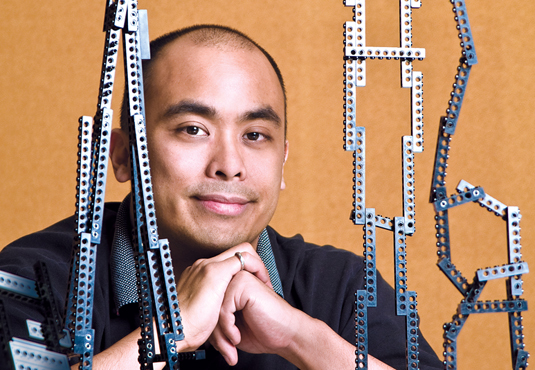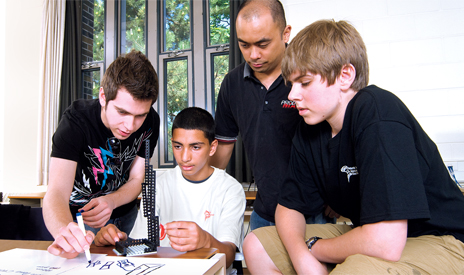 
Vernon Kee, OCT
by Leanne Miller, OCT
Danforth Collegiate and Technical Institute principal David Moore, OCT, says that Vernon Kee is able to do what most teachers can only hope to achieve.
That’s high praise, especially since Kee is just beginning his fourth year of teaching in the Toronto DSB this fall. Moore’s words were part of the nomination package that helped Kee win a Premier’s Award for Teaching Excellence in the New Teacher of the Year category.
Vernon Kee’s teaching approach and philosophy are grounded in his university training and private-sector experience as a professional engineer. He earned his Bachelor of Engineering from Ryerson University in 2001 and worked as a mechanical engineer until 2005 – most recently as a project manager in the automotive industry building robotic welding assembly lines.
The science and computer science teacher balances rigorous academics with hands-on real-world applications. His students operate businesses that design and build LEGO robots. They develop, play and critique video games on the Game Boy platform and investigate paintball physics. They debate Mac versus PC and Xbox versus PS3, and they research video game markets and manufacturers.
Equally important, Kee builds technology into every lesson. He lectures with PowerPoint and shows video clips. Students complete computer simulations and work online.
Kee networks widely with professionals in various fields to ensure that his teaching is current, relevant and engaging. “Friends and family send me articles on engineering and science to share with my students,” he says. “One friend keeps his eye on new software programming trends.”
Two summers ago he learned Python, a computer-programming language that is gaining popularity in academic circles. Then he revamped his Grade 12 computer science program because that’s what students were learning in first-year computer science at the University of Waterloo and the University of Toronto.
“I want to give my students an edge when they go to university.”
Kee gets students to focus on postsecondary opportunities: college, university or the workplace – it doesn’t matter. What does matter is engaging them and encouraging them to excel.
Annette Wilde is the school council chair at Danforth CTI. She spearheaded Kee’s successful nomination and wrote in it that Kee makes students feel special, respected and trustworthy by treating them like adults. “As a result,” Wilde wrote, “students want to contribute – to give back and confirm how valuable they are. I cannot express how important his faith in every student’s inherent value has been for all the students at Danforth CTI.”
So why does a successful engineer change careers and take a 50 per cent pay cut?
Long before he became an engineer, Kee coached high school volleyball and volunteered at camps for at-risk youth.
“I’ve aways liked working with kids,” he says.
Although he excelled in his work as an engineer, he left for what he calls real job satisfaction.
“At the end of the day, if I managed a project amazingly well and made the company millions, it wasn’t going to compare to the effect of changing a life. The greatest lesson I can teach my students is that it’s not the money that determines your happiness but how much you love your job and what you do outside of it.”
What makes him happy is knowing that he’s making a real difference in someone’s life.
And making a difference is what drives him. Kee credits much of his success to the BEd program at the University of Ontario Institute of Technology (UOIT), where he learned strategies and developed skills to engage students. The admiration is mutual. Kee is invited to speak to UOIT’s incoming pre-service students this fall. He hopes to influence their attitudes by reminding them that teaching is a privilege.
It was at UOIT that he mastered PowerPoint with integrated video, LEGO robotics and online learning and testing. “I’m grateful for how my UOIT professors taught me to be a teacher.”
Online lessons allow advanced students to move at their own pace and enable Kee to give others more one-on-one help. As well, when he’s away his students know exactly what to do and they get to work. There’s no pressure on supply teachers to teach something they don’t know, no classroom management challenges and no wasted time for his class. Employees work whether the boss is present or not, and it’s the same for Kee’s students.
It’s not all high-tech, though. Kee’s Grade 9 applied science students are given small white boards. When he asks a question, they write their answers on their boards and hold them up. It’s a quick feedback tool for who’s getting it and who needs help. There’s no stigma of calling out an incorrect answer, no yelling out responses and no seeing the same hands always up in the air.
He also talks regularly about life after high school. He draws what he calls life graphs for individual students – charting and comparing their school, career and life paths in relation to their happiness. His message is that things will always look up, as long as they make school a key component in life and never give up on themselves. He stresses that the choices kids make today have a dramatic impact on their options in the future.
“Think about the choices you make today,” he says. “School is critical, so take it seriously.”
It’s not all serious, though. Kee is a big paintball fan and he knows many kids are too. So he incorporates the game into his physics lessons on force and velocity. And yes, he brings his paintball equipment to school. The kids love it.
Kee regularly seeks feedback to ensure that his program is relevant and engaging. At the end of each Grade 11 and 12 computer science unit, he surveys his students to determine what they understood, if the pace was appropriate and what changes they would like to see for the next unit.
It sounds an awful lot like continuous improvement in business. In fact, Kee takes his inspiration from the Japanese philosophy kaizen, where the corporate structure creates a sense of ownership and pride among employees by giving them the opportunity to make the company better. Kaizen is Japanese for improvement and kaizen activities were widely used in the companies where Kee worked.
Student feedback is consistent. Keep using technology and keep the activities practical, hands-on and fun.
Not only does Kee believe in incorporating what students love, he also believes in sharing what he loves.
“During the first week of school I tell them about my interests and hobbies. I want them to get to know me as a human being and I demonstrate that I want to get to know them in the same way.”
Making strong personal connections with his students is important to Kee. He feels it helps them engage in their learning. He also believes in the importance of connecting with them outside the classroom. Last year Kee ran seven clubs, coached six athletic teams, and mentored students and new teachers – all the while maintaining the school’s web site.
Coaching and sponsoring clubs enables him to get to know students better.
“My classroom management and student success strategies are directly related to my involvement with extracurricular activities,” he explains. “That helps a lot when I’m trying to control a class or create an atmosphere of mutual respect.”
He laughs as he remembers starting a before-school gaming club. “I brought my Xbox to school and the kids couldn’t wait to come in early to play Halo. Even the chronically late kids started coming early. What a bonus.”
Kee also encourages leadership by connecting his students with local and global outreach opportunities. For the past two March breaks he has travelled with students to Nicaragua to volunteer with the underprivileged. They help build schools or work on a medical team.
Kee acknowledges the enormous time commitment involved in his extracurricular work, but seeing kids safe and involved makes him happy. In addition, he can inspire senior students to take on leadership roles.
 |
Students design and build LEGO towers. |
“Sure I manage clubs during lunch most days,” he says, “but that just means I get to eat my lunch while students debate whether running zombies are scarier than walking ones in the Zombie Survival Club.”
Although Kee’s classroom is relaxed and casual, he stresses the importance of management and discipline. Every September he establishes rules and routines by getting his students to agree on unacceptable behaviours and their consequences. As well, he creates a learning environment in which he expects and demonstrates mutual respect.
Kee has discovered that most students are looking for a safe and welcoming environment, both in and outside of classes. Kids visit his classroom before and after school, during lunch and – if there’s room – on their spares while he teaches. They work on the computers, usually doing assignments but sometimes playing games or surfing the Net. It doesn’t matter to Kee, as long as they’re learning. They are respectful and appreciative.
Principal David Moore calls Kee a quiet leader who inspires students and colleagues by doing. “He takes things on. He steps up when students need him.”
Two years ago Kee learned about Toronto Intergenerational Partnerships (TIGP) – the school charity helps connect seniors with youth. He was asked to run their Cyberpals Program, which brings seniors from the residence across the street into the school, where computer science students teach them about the Internet.
TIGP also has a lunch program where school volunteers help provide needy seniors with sandwiches once a week. Members of Kee’s Christian Fellowship Club decided that on holidays they would start serving what they call “big fancy lunches,” cooked by the school’s hospitality department. Most kids stuck around after lunch talking and playing games with the seniors. It was a fantastic outreach program and both he and his students look forward to continuing it this year.
Last June, when school was winding down, Kee was happy with the year but tired. His greatest challenge is the emotional stress of working with teenagers. He gets through it thanks to support from his administration, colleagues and friends. He hopes to receive more training in this area to enable him to better help the kids who share their struggles with him.
“In my interview with the Toronto DSB,” Kee reflects, “they asked me why I wanted to make the career change. I said, ‘I don’t want to build car parts, I want to build lives.’ And as cheesy as it sounds, it is true.”ps
Engaged students = successful students
Vernon’s Kee’s eight strategies to engage students:
- Show that you’re a human being first and they will do the same.
- Use technology in teaching and learning activities. Teach to students’ strengths and interests.
- Use real-life and practical examples that students can relate to, such as paintball, video games, anime (Japanese animation) and manga (Japanese comics).
- Work with students outside the classroom in extracurricular activities. They’ll have a better chance of getting to know and trust you.
- Instill a you-can-do-anything attitude in each student.
- Provide a safe haven for students – before and after school, at lunch and during spares.
- Create an environment of mutual respect.
- Connect school with non-academic life by reinforcing the long-term impact of the choices they make today.
|












